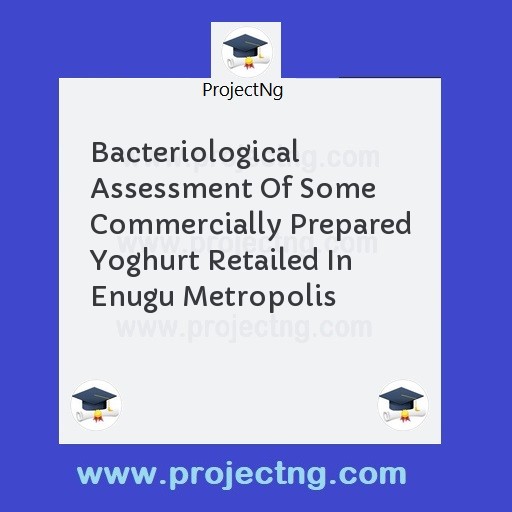Bacteriological Assessment Of Some Commercially Prepared Yoghurt Retailed In Enugu Metropolis
Electrical/electronic Engineering Project Topics
Get the Complete Project Materials Now! »
BACTERIOLOGICAL ASSESSMENT OF SOME COMMERCIALLY PREPARED YOGHURT RETAILED IN ENUGU METROPOLIS
ABSTRACT
Bacteriological assessment of commercially prepared yoghurt was carried out. The pour plate technique was employed using Nutrient Agar, de Man Rogosa Sharpé (MRS) and CLED (Cystein, Lactose, and Electrolyte Deficient Agar) for bacteria. Gram staining and biochemical tests were carried out to identify the bacterial organisms isolated. Out of the five samples of yoghurt analyzed, the total viable bacterial count ranged from 1.5 x 102 to 6.5 x 102cfu/ml. The organisms isolated from the five different brands of yoghurt include species of Staphylococcus, Lactobacillus, Streptococcus, Escherichia coli, and Bacillus. Sample E (fantastic yoghurt) had the highest bacteria count range from (4.5 x 102 to 6.5 x 102 cfu/ml). Bacillus spp was the most isolated organisms in the product.
CHAPTER ONE
INTRODUCTION
1.1 BACKGROUND OF THE STUDY
Diary foods provide and ideal food system for the delivery of beneficial bacteria to the human gut. Given the suitable environment that milk and certain dairy products including yoghurt and cheese) provided, it promotes growth and support viability of these cultures. Diary products such as yoghurt contain ‘probiotic” cultures, e.g Lactobacilli and which are currently among the best known examples of functional food”. Their associated health claims range from alleviation of symptoms of lactose intolerance, treatment of diarrhea, cancer suppression and reduction of blood cholesterol (McDonagh et al, 2007).
Yoghurt is a cultured diary product produced by lactic acid fermentation of milk and is also a means of preserving the nutrients in milk (Hui, 2002; Chandan, 2009). It is generally known as cultured milk, as it is derived from the action of bacterial on all or part of the lactose to produce lactic acid, carbon dioxide, acetic acid, diacetyl, acetaldehyde and several other components that gives the product its characteristic fresh taste (Tamine and Robinson, 2004). It is produced by the lactic fermentation of milk using a combination of bacteria such Lactobacillus bulgaricus and Streptococcus thermophilus (Hui, 2002) and is consumed as a food and thirst quenching beverage (Alfa-Lawal, 2004).
Yoghurt has also been described as a notoriously balanced food containing almost the nutrients present in milk but in a more assimilable form and they can be produced from skimmed or whole milk and there is a large range of flavours available commercially (Anthar, 2006).
Fermented milks, like fresh milk from which they are produced, are liable to contamination. The primary contaminants in yoghurt produced commercially in Nigeria are various bacteria general (Surriayarachchi and Fleet, 2001) which include Bacillus spp which has been found to be the major contaminant of commercially prepared yoghurt. This could be probably be because of easy distribution of their spores in the environment. The spores can withstand harsh environment condition. Bacteria present in yoghurt utilize some of the acid and produce corresponding decreases in the acidity which may favour the growth of putrefactive bacteria (McDonagh et al, 2007).
1.1 OBJECTIVE OF THE STUDY
1) To determine bacteriological safety of yoghurt.
2) To isolate bacterial organisms from yoghurt
3) To determine the bacterial load of yoghurt
1.2 STATEMENT OF PROBLEM
Some yoghurt have been found to loose their taste and produce uncharacteristic odour before their expiry date which may be as a result of contamination through the processing line, packaging and or poor handling. Bacterial infestation has been reported among consumers of yoghurt leading to vomiting, diarrhea, stomach upset and flatulence.
1.3 SIGNIFICANCE OF THE STUDY
The result of this research work would reveal the microbial safety of the yoghurt sample. Also the yoghurt commercially retailed in Enugu is of high quality and all effort should be made to sustain the standard.
1.4 LIMITATION OF THE STUDIES
This research work was limited to bacteriological assessment of some commercial prepared yoghurt retailed in Enugu Metropolis. The cost of media and reagent was high thereby limiting the number of samples for the research work.
Be the First to Share On Social

Enjoying our content?
Don't miss out on new videos! Subscribe to our YouTube channel for more awesome content.
Subscribe Now!













